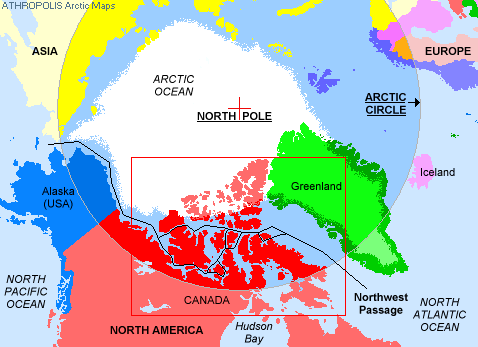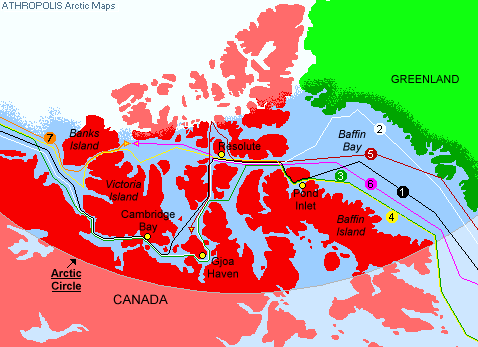
|
HOME |
NEWS |
NORTHWEST PASSAGE LINKS |
LINKS
GUIDE to ARCTIC SUNRISE and SUNSET |

|
HOME |
NEWS |
NORTHWEST PASSAGE LINKS |
LINKS
GUIDE to ARCTIC SUNRISE and SUNSET |
|
|

| The Northwest Passage is a famous sea route linking the Atlantic and Pacific Oceans. It was expected to provide an alternative and shorter passage from Europe to Asia, but as the sea is frozen over for most of the year, this route is not very practical. |

| Click yellow location buttons for weather reports |
| 1. TYPICAL NORTHWEST PASSAGE ROUTE (Black) MORE... |
| 2. ROALD AMUNDSEN: First Navigation by Ship (White) MORE... |
| 3. ST. ROCH: First West-East Crossing (Green) MORE... |
| 4. ST. ROCH: Northern Deep-Water Route (Yellow) MORE... |
| 5. FRANKLIN EXPEDITION: Attempt (Dark Red) MORE... |
| 6. SIR WILLIAM EDWARD PARRY: Attempt (Purple) MORE... |
| 7. ROBERT McCLURE: Proved route existed (Orange) MORE... |
This route, often undertaken with the assistance of an icebreaker, stops at various Nunavut locations such as Pond Inlet, Resolute and Cambridge Bay.
2. ROALD AMUNDSEN: First Navigation by Ship
3. ST. ROCH: First West-East Crossing
4. ST. ROCH: Northern Deep-Water Route (East-West)
5. FRANKLIN EXPEDITION: Attempt
6. SIR WILLIAM EDWARD PARRY: Attempt
7. ROBERT McCLURE: Proved Route Existed
( NOTE: Even though icebergs are present in the Northwest Passage, as of this date, no icebergs have been spotted with castles on top of them.) |
